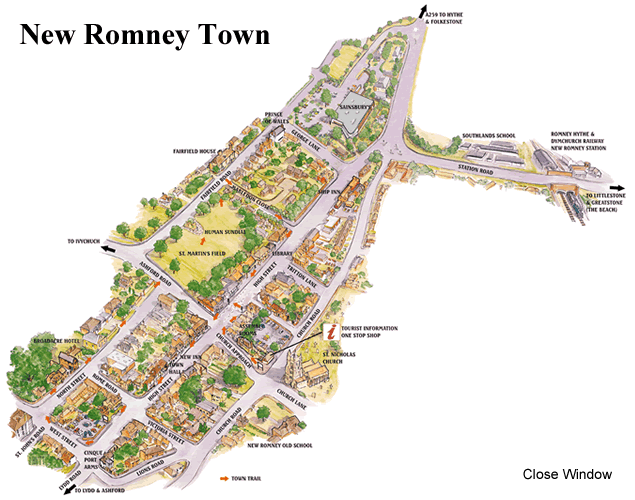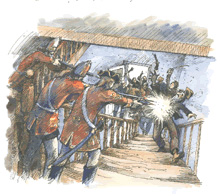Romney Marsh Countryside Partnership
New Romney Town Trail

Welcome to New Romney
While you are here, we hope you will have the time to follow the Town Trail to discover some of the stories of this attractive bustling Cinque Port town. The walk will take about 30 minutes – follow the route shown on the map. There are plenty of places to stop for refreshment, and the local shops will welcome your custom while you are here.
Cinque Port Town
In 1278 Edward I granted a charter to the Cinque Ports and Confederate Towns, which included New Romney. The Cinque Ports provided the Sovereign with a fleet of ships for defence which also served as private transport for the King. The five original Head Ports were New Romney, Sandwich, Dover, Hythe, and Hastings and they enjoyed important privileges for over 200 years.
The Great Storms
During the 13th century violent storms swept the local coastline. New Romney was devastated by these ferocious storms. The harbour was lost, shingle and mud were swept into the town, severing its links with the sea and changing its fortunes forever.
Please Step Down
William the Conqueror’s half-brother Bishop Odo, is believed to have started building St. Nicholas’ church in 1080. Stone was imported from Caen and it took 50 years to build the church – longer than the lives of many of its builders. The western entrance to the church lies lower than the road. This is testimony to the power of the 13th century storms which brought huge amounts of sand and shingle into the town, raising local ground level, and filling the harbour.
Back to School
Opposite the church is the Old School. The last pupils were taught in this building in 1974. The building has been restored through a real partnership of local fund raising efforts and grants received from the Heritage Lottery Fund, local charities, Folkestone and Hythe District Council and Kent Rural Development Area amongst others. The Old School now holds local artefacts and is a place for educational training.
New Inn
The churchyard is the final resting place of Lieutenant Thomas Edgar who sailed the oceans in the company of Captain Cook. Edgar was a skilled mariner in his own right whose survey of the West Falkland Islands in 1786 gave rise to the naming of Port Edgar. His tombstone now sits in the north chapel of the Church. Many local smugglers are also buried at Lydd including Francis Sisley who smuggled silks and laces with the help of his son Thomas based in France. Francis was to become great-grandfather to the Impressionist painter Alfred Sisley.
The Ghostly Maid
During the 18th century a young woman called Elizabeth was found hanging from the staircase in the New Inn, rumoured sightings of this mysterious lady walking the hallways and rooms of the inn cannot be confirmed or denied!
Open Arcade
The Town Hall originally dates from the 16th century when it had an open arcade at ground level for trading livestock. It wasn’t until the early 18th century that the building became the Town Hall. The adjoining jail, or ‘small port’ as it was called, was built in 1750, with heavy wooden doors and iron grated windows.
Take it Away
The Chinese takeaway on the corner of Lydd Road was once the Victoria Hotel. This was the centre of a thriving transport business run by Mr. Moody who operated services to Folkestone at the turn of the 20th century.
John Southland
Several of the houses in West Street opposite the car park are thought to be part of the monastery and are some of the oldest buildings in New Romney. Adjoining them are cottages left by John Southland in 1610 as an abiding place for the elderly of the town. The town’s school in Station Road is named after him.
St. Martin’s Field
New Romney was once a prosperous town with five churches. On St. Martin’s FieId, near the Human Sundial, is the site of the oldest church in New Romney. St. Martin’s Church was built by the Saxons to serve what was then a fishing village. By 1550 it had fallen into a state of disrepair as the town could not afford the upkeep of both St. Nicholas’, and St. Martin’s churches. Its demolition was finally agreed by Archbishop Cranmer.
Foreign Grounds
The priory building dates back to around 1270 and was probably attached to a home for lepers. As the priory was a religious foundation rather than a parish church. It was technically a foreign priory. Whenever France and England were in dispute the priory was seized by the then King and restored on the return of peace.
Sheep Fair
Romney sheep or ‘Kents’ are one of the most ancient breeds in Britain. Vast flocks numbering up to 180,000 used to graze the rich pastures of the Marsh a century ago. The sheep were brought into New Romney, to market on Fairfield Road near to Fairfield House. The stock fair was held on the 21st August and a general fair for the locals was held the next day. Today the successful New Romney Country Fair is usually held on the first Saturday of August.
The Owlers
The wool of the Romney Marsh sheep is thick, dense and of high quality, it was in great demand in France during the 17th and 18th centuries. The high custom and export taxes imposed encouraged an illicit trade in the fleeces which were smuggled from the Marsh to France. Most smuggling took place at night – the eerie calls that the smuggling men used gave them the local name of ‘the Owlers’. In 1698 most of the fleeces of 160,000 sheep shorn on the Marsh were smuggled to France. The smuggling peaked on the Marsh in 1780.
The Old Forge
New Romney Library stands on the site of one of the two town forges. The second forge was next to the Cinque Port Arms pub at the other end of the High Street.


